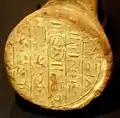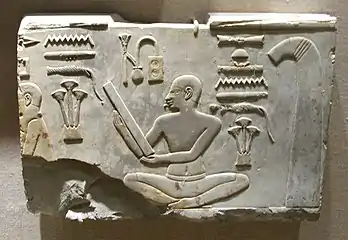Knot (hieroglyph)
The ancient Egyptian knot hieroglyph, or girdle knot, Gardiner sign listed no. S24, portrays a reef knot. Besides its use as a hieroglyph, it has usage in statuary and reliefs. The knot hieroglyph is also an amulet, typically made of worked stone, or as jewellery elements.[1]
| Knot in hieroglyphs | ||
|---|---|---|

Language usage
The knot hieroglyph is used in the Egyptian language as the verb, (th)s, (th)ss, for to knot, to tie, to tie together, etc.
It is used as the phonogram for (th)s, as well as the determinative. There are many alternate spellings. For the noun, it is Egyptian language (th)s, (th)s.t,
for meanings of: knot, tie, ligature, backbone, vertebrae, spine, etc.
In jewellery and decoration
The knot used as an article of jewellery was especially known in the Middle Kingdom. It can be found in necklaces (see gallery photo), and as a small brooch. In Amulets of Ancient Egypt, a two-part, hollow gold piece is shown, with a detailed rope-detailed fiber; it is made with a tongue and groove closure for the parts.[2]
Gallery
 Funerary cone using the 'girdle-knot hieroglyph'
Funerary cone using the 'girdle-knot hieroglyph' Small bandlet made of 16 knot-pieces
Small bandlet made of 16 knot-pieces Relief from reign of Hatshepsut
Relief from reign of Hatshepsut
See also
References
- Andrews, 1994. Amulets of Ancient Egypt.
- Andrews, 1994. p. 44, plate 49b.
- Andrews, Carol, 1994. Amulets of Ancient Egypt, chapter 4: Scarabs for the living and funerary scarabs, pp 50–59, Andrews, Carol, c 1993, University of Texas Press, 518 amulets, 1, or multiples included in 12 necklaces; (softcover, ISBN 0-292-70464-X)
- Budge. An Egyptian Hieroglyphic Dictionary, E.A.Wallace Budge, (Dover Publications), c 1978, (c 1920), Dover edition, 1978. (In two volumes, 1314 pp, and cliv-(154) pp.) (softcover, ISBN 0-486-23615-3)